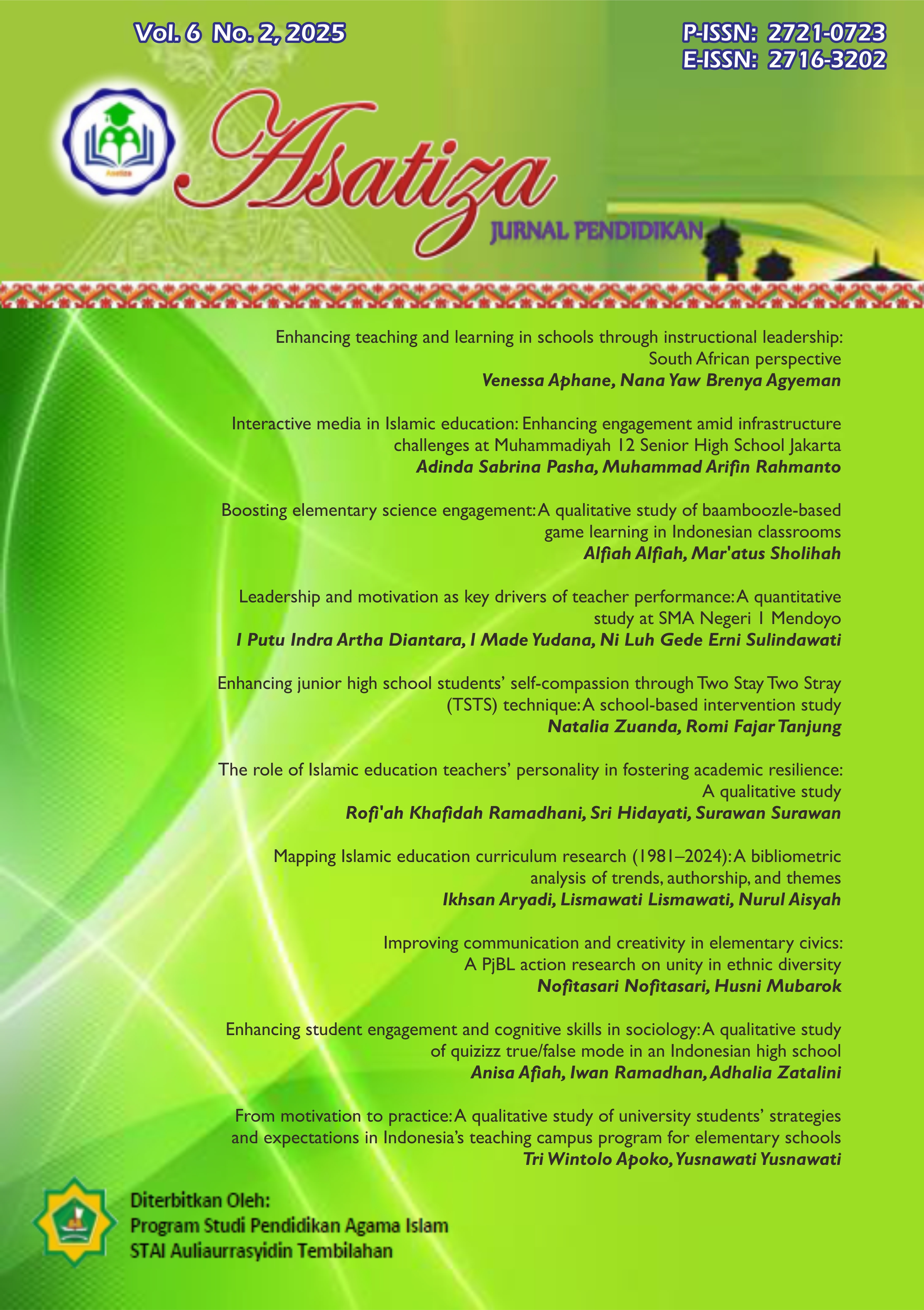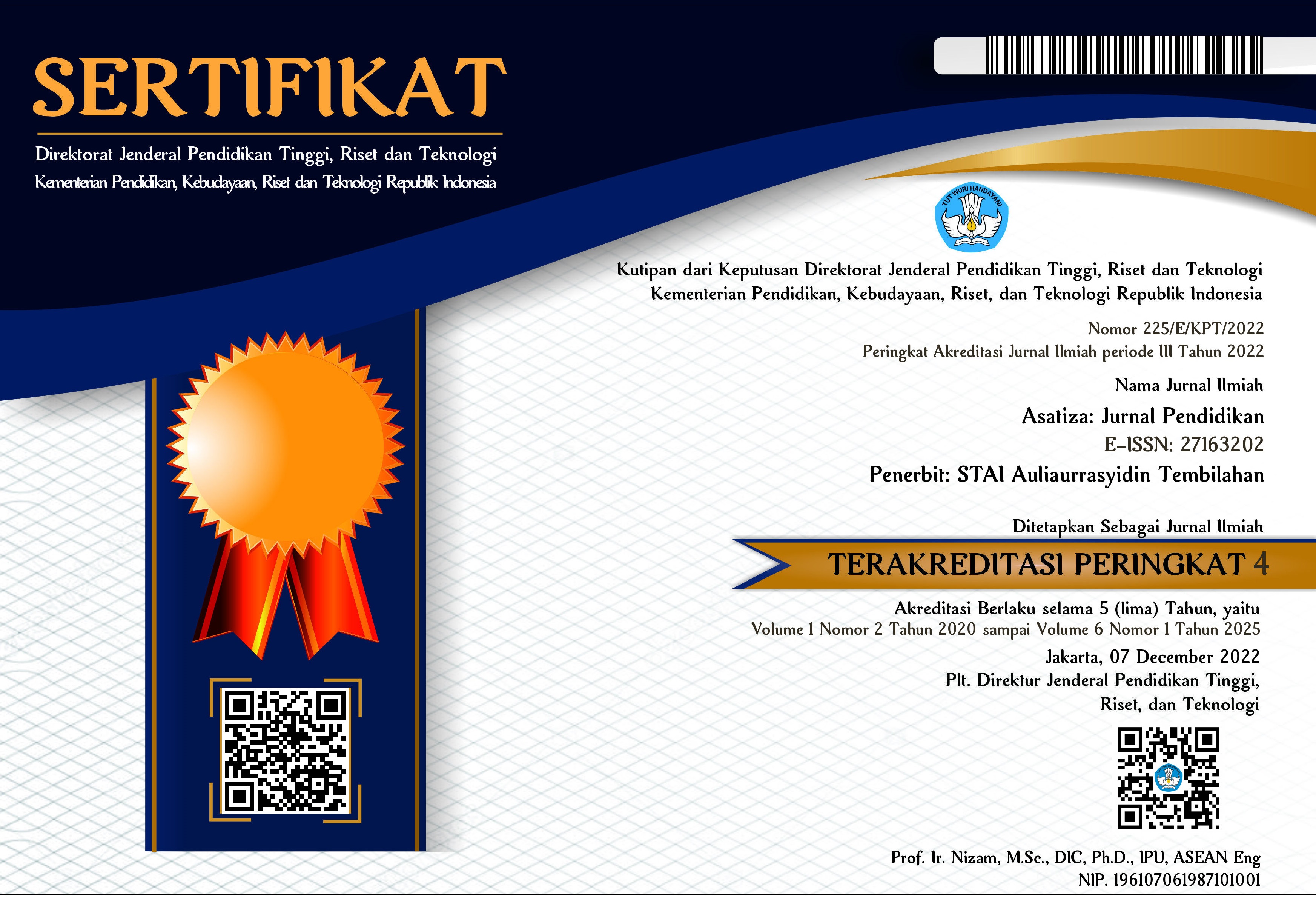Enhancing junior high school students’ self-compassion through Two Stay Two Stray (TSTS) technique: A school-based intervention study
DOI:
https://doi.org/10.46963/asatiza.v6i2.2781Keywords:
Classical Guidance and Counseling, Two Stay Two Stray, Self-CompassionAbstract
This study investigates the effectiveness of classical guidance and counseling services in enhancing self-compassion among junior high school students using the Two Stay Two Stray (TSTS) technique. Employing a quantitative pre-experimental design with a one-group pretest-posttest approach, the research addresses constraints in scheduling by utilizing other subjects’ class hours. The population comprised 125 students, with a sample of 22 selected through simple random sampling. The chosen class exhibited low self-compassion levels, characterized by self-judgment and isolation, based on preliminary observations. Data were collected using an instrument adapted from Kristin Neff’s self-compassion scale, measuring three key aspects: self-kindness, common humanity, and mindfulness. SPSS 22 analysis revealed normal distribution of data (pretest *p* = .376; posttest *p* = .406), confirming parametric test assumptions. The findings highlight the potential of integrating TSTS into classical counseling to foster self-compassion in adolescents—a critical skill for navigating life’s challenges. This study contributes an innovative intervention model and serves as a reference for developing evidence-based strategies in school counseling.
Downloads
References
Allen, A. B., & Leary, M. R. (2010). Self-Compassion, stress, and coping. Social and Personality Psychology Compass, 4(2), 107–118. https://doi.org/10.1111/j.1751-9004.2009.00246.x
Apsari, D. A., & Budi Utomo, H. (2024). Pentingnya self-compassion bagi kesehatan mental individu. Psikodinamika: Jurnal Literasi Psikologi, 4(1), 025–033. https://doi.org/10.36636/psikodinamika.v4i1.4167
Azwar, S. (2012). Metode Penelitian. Yogyakarta: Pustaka Pelajar
Bandura, A. (1997). Self-Efficacy - The Exercise of Control, New York: W.H. Freeman and Company
Bluth, K., Mullarkey, M., & Lathren, C. (2018). Self-Compassion: A potential path to adolescent resilience and positive exploration. Journal of Child and Family Studies, 27(9), 3037–3047. https://doi.org/10.1007/s10826-018-1125-1
Bui, T. H. T., Nguyen, T. N. T., Pham, H. D., Tran, C. T., & Ha, T. H. (2021). The mediating role of self-compassion between proactive coping and perceived stress among students. Science Progress, 104(2), 1–14. https://doi.org/10.1177/00368504211011872
Diorarta, R., & Mustikasari. (2020). Tugas perkembangan remaja dengan dukungan keluarga: Studi kasus. Carolus Journal of Nursing, 2(2), 111–120. https://doi.org/10.37480/cjon.v2i2.35
Gillies, R. M. (2016). Cooperative learning: Review of research and practice. Australian Journal of Teacher Education, 41(3), 39–54. https://doi.org/10.14221/ajte.2016v41n3.3
Hasmarlin, H., & Hirmaningsih, H. (2019). Self-Compassion dan regulasi emosi pada remaja. Jurnal Psikologi, 15(2), 148. https://doi.org/10.24014/jp.v15i2.7740
Hytman, L., & Kocovski, N. L. (2023). Self-Compassion and grit in the context of social judgment. SAGE Open, 13(3), 1–9. https://doi.org/10.1177/21582440231194209
Neff, K. D. (2015). The proven power of being kind to yourself. Harper Collins Publisher, 47–48.
Neff, K. D. (2023). Self-Compassion : Theory , Intervention.
Neff, K. D., & Germer, C. K. (2013). A pilot study and randomized controlled trial of the mindful self-compassion program. Journal of Clinical Psychology, 69(1), 28–44. https://doi.org/10.1002/jclp.21923
Neff, K. D., & McGehee, P. (2010). Self-compassion and psychological resilience among adolescents and young adults. Self and Identity, 9(3), 225–240. https://doi.org/10.1080/15298860902979307
Ramadhan, F. E. N., & Suyanto, W. (2019). Implementasi metode pembelajaran two stay two stray untuk meningkatkan keaktifan dan hasil belajar teknologi dasar otomotif siswa kelas x Tkrb SMKN 1 Sedayu. Jurnal Pendidikan Vokasi Otomotif, 1(2), 1–14. https://doi.org/10.21831/jpvo.v1i2.24300
Rifdah El Fiah. (2014). Buku Lengkap Dasar dasar BK ibu Rifda.pdf (pp. 1–226).
Soegiyono. (2011). Metode Penelitian Kuantitatif, Kualitatif dan R&D.
Suryana, E., Hasdikurniati, A. I., Harmayanti, A. A., & Harto, K. (2022). Perkembangan remaja awal, menengah dan implikasinya terhadap pendidikan. Jurnal Ilmiah Mandala Education, 8(3), 1917–1928. https://doi.org/10.58258/jime.v8i3.3494
Wason, S., & Sims, C. (2024). The experience of self-compassion training among NHS healthcare professionals. Journal of Health Psychology. https://doi.org/10.1177/13591053241267041
Downloads
Published
Issue
Section
License
Copyright (c) 2025 Natalia Zuanda, Romi Fajar Tanjung

This work is licensed under a Creative Commons Attribution-ShareAlike 4.0 International License.
Authors who publish with this journal agree to the following terms:
1. Copyright on any article is retained by the author(s).
2. The author grants the journal, right of first publication with the work simultaneously licensed under a Creative Commons Attribution shareAlike 4.0 International License that allows others to share the work with an acknowledgment of the work’s authorship and initial publication in this journal.
3. Authors are able to enter into separate, additional contractual arrangements for the non-exclusive distribution of the journal’s published version of the work (e.g., post it to an institutional repository or publish it in a book), with an acknowledgment of its initial publication in this journal.
4. Authors are permitted and encouraged to post their work online (e.g., in institutional repositories or on their website) prior to and during the submission process, as it can lead to productive exchanges, as well as earlier and greater citation of published work.
5. The article and any associated published material is distributed under the Creative Commons Attribution-ShareAlike 4.0 International License











2.png)



